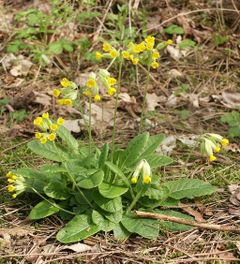| May Plants and Herbs Cowslip
Primula veris (Cowslip; syn. Primula officinalis Hill) a flowering plant in the genus Primula. Native to temperate Europe and Aia but not in far northern areas. Cowslip is a medicinal plant: Diuretic, expectorant, antispasmotic. Used to treat headaches, whooping cough and tremors. Cowslips are made into wine and used to flavor wine. Also known as "paigle" or herb Peter as it is related to St. Peter who dropped his heavenly keys and a cowslip grew from the spot. They were used for garlands and maypoles. County flower of Essex, Northamptonshire, Surrey, and Worcestershire counties of England. t To return to the top click here Hawthorn
Crataegus monogyna, or Common Hawthorn, a species of hawthorn native to Europe, northwest Africa and western Asia. Other names are may, mayblossom, maythorn, quickthorn, motherdie, and haw. A broadly spreading shrub or small tree 5-14 m tall, with a dense crown. The bark is dull brown with vertical orange cracks. The younger stems bear sharp thorns, 1 to 1.5cm long. Leaves are 2-4 cm long, obovate and deeply lobed, sometimes almost to the midrib, with the lobes spreading at a wide angle. The upper surface is dark green above and paler underneath. Flowers appear in May. Gaelic folklore associates the hawthorn with the entrance to the otherworld. The plant is associated with the faries. It is unlucky to cut the tree at any time other than when it is in bloom. It is then used as a May Bush. The bushes are also associated with clootie or sacred wells where strips of cloth are tied to them for healing purposes. To return to the top click here Woodruff
Woodruff (Galium odoratum) Herbaceous perennial of the family Rubiaceae native to Europe, North Africa and Western Asia. Grows to be as tall as 12-20 inches and lies flat on the ground. Also known as Sweet Woodruff and Wild Baby's Breath or Master of the woods. Woodruff has a strong sweet scent which comes from courmarin. The scent is strong when the plant wilts and remains after it is dried. It is used both for potpourri and as moth deterrent. In Germany it is used to flavor May wine, beer, brandy, sausages, jelly and jam and a soft drink, ice cream and herbal tea. It is said to have sedative properties. Too much Woodruf can caws headaches, vertigo, somnolence, central paralysis and apnoea. It has largely been replaced with artifical aromas and colorings.
To return to the top click here
To return to the top click here |


